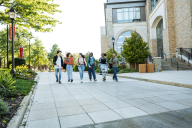You have /5 articles left.
Sign up for a free account or log in.
California State University system students celebrate at graduation. CSU is one of the highest-ranked systems in the Economic Mobility Index.
Excelencia in Education
A new report, released Wednesday, says minority-serving institutions are continuing to lead the way in providing students an education that provides economic opportunity and social mobility.
The report by Third Way, a center-left think tank, highlights the organization’s second annual Economic Mobility Index (EMI), which measures how well institutions help their students improve their socioeconomic status. It reflects a national shift in higher ed toward emphasizing the affordability of colleges and universities and the return on investment they provide to students.
This was the second year in a row that the report lauded the significant role minority-serving institutions, or MSIs, play in the academic and socioeconomic outcomes of students of color. Institutions across the board that are committed to promoting access for low- to moderate-income students by offering low tuition costs and a quick return on investment performed strongly.
“The No. 1 reason students are going to school is for economic return,” said Chazz Robinson, an education policy adviser at Third Way. “We can talk about so many other factors—which we believe do matter in the educational system—but when a student graduates, they’re going to be wanting to try to get a good job … We think that matters a great deal not just for the student, but for the economy as a whole.”
Using the latest data from the College Scorecard, released this spring, the index measured two key values: price-to-earning premiums, or PEP, which determine how long it takes for low-income students to recoup their education costs (it’s a metric on which elite institutions often perform well) and the percentage of Pell Grant–eligible students that each institution enrolls. By factoring in which colleges serve low-income students well and which ones enroll a large share of them, it “completely changes the conversation,” Robinson said.
“If the student goes to Harvard, they’re probably going to have a good outcome,” Robinson said. “It’s just, how many of these students enrolling are from low- and moderate-income backgrounds?”
Changes in the results from last year’s data analysis to this year were subtle. Robinson noted that this year’s calculations were based on low-income students’ median rather than mean postgraduate earnings, which better accounted for potential outliers. Third Way also chose to only classify institutions by the tier, or quintile, in which they fell, because there was “no functional difference” between a college ranked 25th and one ranked 30th. (While results weren’t explicitly ranked, they were still listed in numerical order.)
This year’s analysis chronicled the continuation of trends highlighted in the first report in 2022. Hispanic-serving institutions, or HSIs—those with an undergraduate enrollment of at least 25 percent Hispanic students—made up nearly one-third (99) of the 281 institutions in the EMI’s first tier or top 20 percent. Many were concentrated in California, New York and Texas specifically.
Historically Black colleges and universities, seven of which landed in the first tier, also performed better using Third Way’s economic mobility index than in traditional rankings.
Emily Labandera, the director of research at Excelencia in Education, an advocacy organization for Latino students, attributed MSIs’ success in fostering economic mobility to “intentionality.”
“We know that Latino students over all represent what we at Excelencia call a posttraditional student profile,” Labandera said. “It’s that knowledge of the community they’re serving and having strategies, programs, practices, leadership, all aligning to what serves that profile of students.”
“You’ll always hear us say, what serves Latino students serves all,” she added. “A college degree doesn’t just uplift that one student, but it uplifts an entire family.”
In addition to MSIs, many of the institutions ranked in the top tier were broad-access and/or public regional colleges and universities. Several of the top 20 institutions in this year’s report belong to the same state systems. The California State University system, for example, had eight institutions in the top 20, and the City University of New York system had five.
Robinson said that while economic mobility was possible at more academically rigorous flagship institutions and private liberal arts colleges, public regional institutions excelled in EMI rankings because of their geographic locations and their ability to adapt to the needs of different student populations.
“Sometimes these schools have a greater reach to low-income students, which we have to acknowledge, they might be in more urban areas or population centers,” Robinson said. “They really recognized the population that they serve, and they started to build their cultures and their policies around those students so they can go ahead and be successful.”
Colin Hill, a technical research analyst for postsecondary education at MDRC, a nonpartisan research organization, sees these “comprehensive approaches to student support” as “instrumental for institutions to foster economic mobility.”
And in systems where such practices have already been implemented, it’s clear that they’re working. They’re “propelling low- and middle-income students into economic mobility,” he said.
The City University of New York system’s program Accelerate, Complete, and Engage (ACE), which provides comprehensive student support and academic services, for example, boosted four-year graduation rates by over 12 percentage points, according to the Third Way report.
They work because they “meet students where they’re at,” Hill explained.
“Students … are coming from all different economic backgrounds, from different social backgrounds, different cultural backgrounds, and they have varying levels of needs,” Hill said. “What comprehensive approaches the student [supports] have to offer is that they’re really adaptable … Having a really dedicated adviser that is able to connect students to the various resources, whether that’s on campus or in the larger community, allows students to complete their degrees, go into the labor market, and see that really fast return on investment.”








